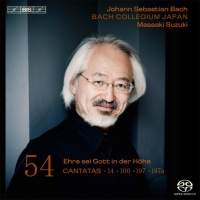Texte paru dans: / Appeared in:

Fanfare Magazine: 37:4 (03-04/2014)
Pour
s'abonner / Subscription information
Les abonnés à Fanfare Magazine ont accès aux archives du
magazine sur internet.
Subscribers to Fanfare Magazine have access to the archives of the magazine
on the net.
BIS
BIS2021

Code-barres / Barcode : 7318599920214 (ID408)
This is the latest, though presumably not the last, release in Suzuki’s Bach sacred cantatas survey. I’ve been following it from the start, collecting each volume as it came out, and I made a spreadsheet for myself to keep track of which cantatas had been accounted for and which were still outstanding. According to my ledger, still to go are the cantatas Nos. 30, 191, 193, 198, and 217–220. The absence of No. 30, Freue dich, erlöste Schar, is particularly surprising to me; since it’s one of Bach’s more popular cantatas, I’d have expected Suzuki to get to it sooner. There are also a couple of other cantatas at either end of the list that may or may not eventually be included. At the low end is No. 11, Lobet Gott in seinen Reichen, alternately known as the Ascension Oratorio, and at the high end is No. 249, Kommt, eilet und laufet, better known as the Easter Oratorio. In parallel, as you may know from previous reviews, Suzuki is also surveying Bach’s wedding and secular cantatas in a separate series.
If you’re familiar with Suzuki’s sacred cantatas cycle, this new release will hold no surprises for you. Since its inception in 1995, the conductor’s ongoing effort with his Bach Collegium Japan and roster of vocal soloists, has, in my opinion, been the most consistently even and satisfying of all the Bach cantata surveys, including Gardiner’s live “Bach Pilgrimage” series. To be sure, not every one of Suzuki’s soloists has been ideal—more on that in a moment—and you can certainly find versions of favorite individual cantatas, in both period and modern instrument performances, that may feature singers with more appealing voices or that you may find more musically satisfying. But on the whole, Suzuki has offered dependable, historically informed readings, well-researched notes with full texts, and, beginning with Volume 28, impressive, full-spectrum SACD sound.
Three cantatas bear the name Was Gott tut, das ist wohlgetan (What God does is well done), Nos. 98, 99, and 100. The first composed was No. 99, written in 1724 for the 15th Sunday after Trinity. No. 98 was composed in 1726 for the 21st Sunday after Trinity. No. 100 on the present disc wasn’t written until 1734–1735, and its intended occasion is uncertain. It’s the largest, most festive, and most elaborately scored of the three, leading some to believe that it was composed for a wedding.
No. 14, Wär Gott nicht mit uns diese Zeit (If God were not with us at this time), dates from 1735 and was composed for the fourth Sunday after Epiphany. According to the booklet note, it’s one of the cantatas Bach wrote to fill in the gaps of the 1724–1725 cycle he hadn’t completed. Lasting only 14 1/2 minutes, it’s one of the shorter cantatas, having no aria or recitative for alto.
Nos. 197 and 197a need to be explained together. No. 197a, Ehre sei Gott in der Höhe (Glory to God in the highest), survives only as a fragment consisting of an alto aria, a recitative and aria for bass, and a closing chorale. It’s believed, however, to have been composed for Christmas Day in 1728 or possibly 1729.
Gott ist unsre Zuversicht (God is our confidence), No. 197, was composed much later, in 1736–1737, and is said to be a wedding cantata, though for whose marriage is not known. Though based on a different text than No. 197a, No. 197 is referred to as a parody cantata, which is a tactful way of saying that Bach cannibalized some of the music he’d written for No. 197a and reset it to new words in No. 197. This is a big cantata, scored for two oboes, two oboes d’amore, bassoon, three trumpets, timpani, and strings, and it’s divided into two parts.
In a recent review (36:4) of another wedding cantata by Bach, No. 195, Dem Gerechten muss das Licht (The Righteous must always sow the light), I doubled over with laughter at reading the liner note, which referred to the piece as the “Copulations Cantata.” Perhaps I shouldn’t have been too quick to guffaw, because Part II of No. 197 on this disc bears the formal title “Post Copulationem,” so this reference to the “after wedding” act of consummation must have been a conventional expression of the day.
If there is one weak link in the performances, it’s not among the chorus or the four solo vocalists, all of whom cover themselves with laurels. Veteran bass, Peter Kooij, is always a pleasure to hear, but I would especially single out countertenor Damien Guillon, who has finally managed to convince me that the male alto voice needn’t be cringe-worthy, and that is quite an accomplishment.
No, I’m afraid the weak link on this volume is the lead trumpeter, Jean-François Madeuf. His smudged passagework, simulation of trills, and microtonal intonation in the soprano aria “Unsre Stärke heiss zu schwach” from Cantata No. 14 are, to put it politely, subpar, spoiling an otherwise fine vocal performance by Hana Blažiková. As I’ve said elsewhere in another review, there’s a reason God created valves.
But for this one blight, we have here another excellent entry in Suzuki’s cantata cycle, which, by my reckoning, should take another two or three discs to complete.
Cliquez l'un ou l'autre
bouton pour découvrir bien d'autres critiques de CD
Click either button for many other reviews


